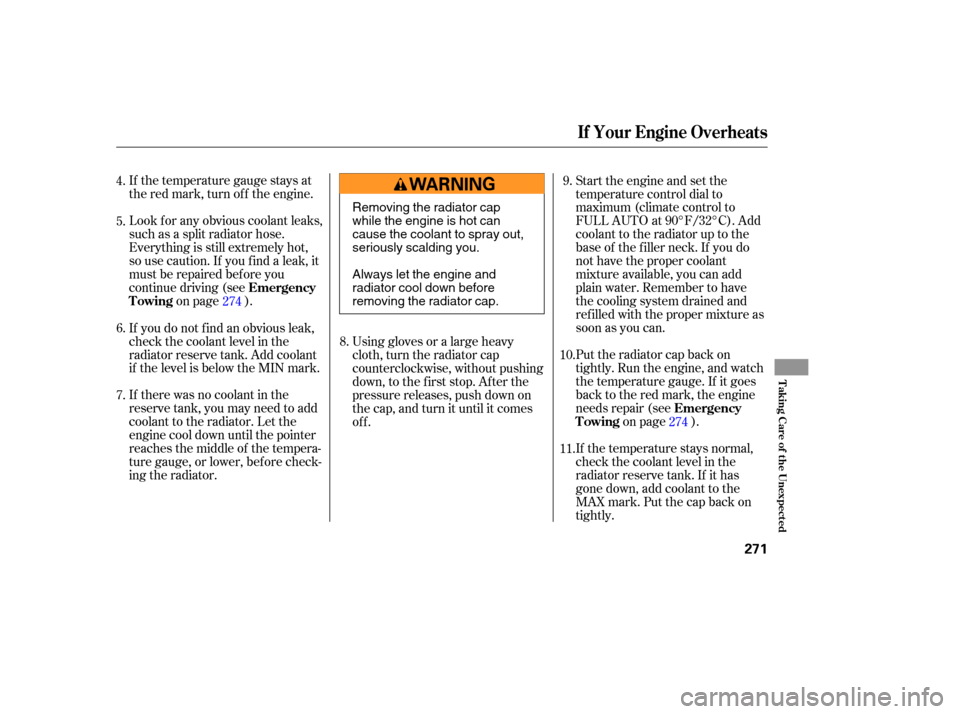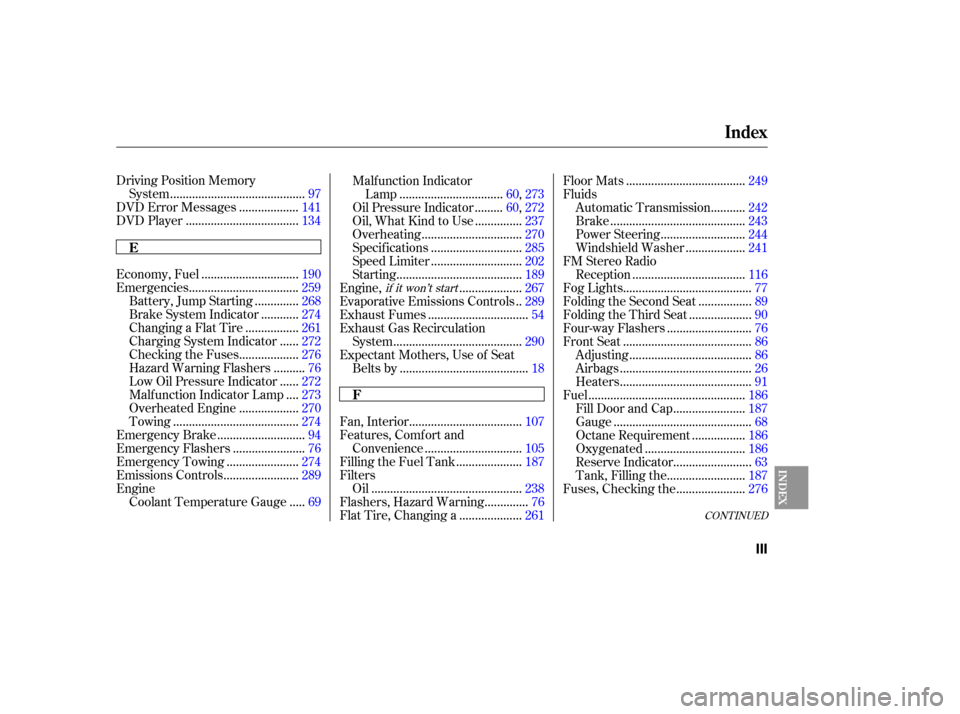engine overheat Acura MDX 2005 Owner's Manual
[x] Cancel search | Manufacturer: ACURA, Model Year: 2005, Model line: MDX, Model: Acura MDX 2005Pages: 312, PDF Size: 4.1 MB
Page 1 of 312

2005 MDX Online Reference Owner's Manual
Use these links (and links throughout this manual) to navigate through\
this reference.
For a printed owner's manual, click on authorized manuals or go to www.h\
elminc.com.
Contents
Introduction ........................................................................\
............................................................... i
A Few Words About Safety........................................................................\
........................................ ii
Your Vehicle at a Glance........................................................................\
........................................... 4
Driver and Passenger Safety ........................................................................\
.................................... 7
Seat belts, SRS, and child protection.
Instruments and Controls........................................................................\
......................................... 57
Indicators, gauges, dashboard, and steering column.
Features ........................................................................\
..................................................................... 105
Climate, audio, rear entertainment, steering wheel, secruity, cruise con\
trol, HomeLink and Onstar
Before Driving........................................................................\
.......................................................... 185
Fuel, vehicle break-in, and cargo loading.
Driving ........................................................................\
..................................................................... . 197
Engine and transmission operation.
Maintenance........................................................................\
............................................................. 227
Schedules, fluid checking, minor services, and vehicle storage.
Taking Care of the Unexpected........................................................................\
.............................. 259
Flat tire, dead battery, overheating, fuses.
Technical Information........................................................................\
............................................ . 281
Vehicle specifications, tires, fuels, and emissions controls.
Warranty and Customer Relations (U.S. and Canada)................................................................ 295
Warranty and contact information.
Authorized Manuals (U.S. only)........................................................................\
.............................. 299
How to order.
Index........................................................................\
........................................................................\
..... I
Service Information Summary
Fluid capacities and tire pressures.
Important Handling Information. ........................................................................\
................... iii
Page 207 of 312

Each tire has its own pressure
sensor. If the air pressure of a tire
becomes signif icantly low, the
sensor in that tire immediately sends
a signal that causes the low tire
pressure indicator and the
appropriate tire on the tire pressure
monitor to come on. Your vehicle is equipped with a tire
pressure monitoring system (TPMS)
that turns on every time you start the
engine and monitors the pressure in
your tires while driving.When the tire pressure monitoring
system warning light is lit, one or
more of your tires is signif icantly
under-inf lated. You should stop and
check your tires as soon as possible.
If you think you can saf ely drive a
short distance to a service station,
proceed slowly, and inf late the tire to
the recommended pressure shown
on the driver’s doorjamb.
If the tire is f lat, or if the tire
pressure is too low to continue
driving, replace the tire with the
compact spare tire.Driving on a signif icantly under-
inf lated tire causes the tire to
overheat and can lead to tire failure.
Under-inf lation also reduces f uel
efficiency and tire tread life, and may
af f ect the vehicle’s handling and
stopping ability.
Although your tire pressure is
monitored, each tire should be
checked monthly, including the
spare.
Check the pressure with the tires
cold, af ter the vehicle has been
parked f or at least 2 hours.
Set to the recommended inf lation
pressure as specif ied on the vehicle
placard and in the owner’s manual
(see page ).
252
Tire Pressure Monitoring System (TPMS)
Low Tire Pressure
Indicator
Driving
205
Page 223 of 312

When climbing hills, closely watch
your temperature gauge. If it nears
the red (hot) mark, turn the air
conditioning of f , reduce speed and, if
necessary, pull to the side of the
road to let the engine cool.
If the transmission shif ts f requently
while going up a hill, shif t to D3.
If you must stop when f acing uphill,
use the f oot brake or parking brake.
Do not try to hold the vehicle in
placebypressingontheaccelerator,
this could cause the automatic
transmission to overheat.
When driving down hills, reduce
your speed and shif t down to D . Do
not ‘‘ride’’ the brakes.Crosswinds and air turbulence
caused by passing trucks can disrupt
your steering and cause trailer
swaying. When being passed by a
large vehicle, keep a constant speed,
and steer straight ahead. Do not try
to make quick steering or braking
corrections.
Always drive slowly and have
someone guide you when backing up.
Grip the bottom of the steering
wheel, then turn the wheel to the lef t
to get the trailer to move to the lef t.
Turn the wheel to the right to move
the trailer to the right.
Follow all normal precautions when
parking, including putting the
transmission in Park and f irmly
setting the parking brake. Also, place
wheel chocks at each of the trailer’s
tires.If the vehicle’s tires slip when
retrieving a boat f rom the water,
shif t to f irst gear, and turn on VTM-4
Lock (see page ). Disengage
VTM-4 Lock as soon as the boat is
out of the water to prevent damage
to the VTM-4 system.
204
3
Towing a Trailer
Driving on Hills
Handling Crosswinds and Buf f et ing
Backing UpParking Ret rieving a Boat
Remember, it
takes longer to slow down and
stop when towing a trailer.
Driving
221
Page 261 of 312

This section covers the more
common problems that motorists
experience with their vehicles. It
gives you inf ormation about how to
safely evaluate the problem and what
to do to correct it. If the problem has
stranded you on the side of the road,
you may be able to get going again.
If not, you will also f ind instructions
on getting your vehicle towed.......................
Compact Spare Tire .260
....................
Changing a Flat Tire .261
..........
If Your Engine Won’t Start . 267
................................
Jump Starting .268
............
If Your Engine Overheats . 270
.........
Low Oil Pressure Indicator . 272
..........
Charging System Indicator . 272
.......
Malf unction Indicator Lamp . 273
...............
Brake System Indicator . 274
......................
Emergency Towing .274
..............................................
Fuses .275
..............................
Fuse Locations .278
Taking Care of the Unexpected
T aking Care of t he Unexpect ed
259
Page 272 of 312

Saf ely pull to the side of the road.
Put the transmission in Neutral or
Park, and set the parking brake.
Turn of f all accessories, and turn
on the hazard warning indicators.
If you see steam and/or spray
coming f rom under the hood, turn
of f the engine. Wait until you see
no more signs of steam or spray,
then open the hood.
If you do not see steam or spray,
leave the engine running, and
watch the temperature gauge. If
the high heat is due to overloading,
the engine should start to cool
down almost immediately. If it
does, wait until the temperature
gauge comes down to the midpoint,
then continue driving.
The pointer of your vehicle’s
temperature gauge should stay in
the midrange. If it climbs to the red
mark, you should determine the
reason.
If the vehicle overheats, you should
take immediate action. The only
indication may be the temperature
gauge climbing to or above the red
mark. Or you may see steam or
spray coming f rom under the hood.
1.
2.
3.
If Your Engine Overheats
If Your Engine Overheats
270
Steam and spray from an
overheated engine can
seriously scald you.
Do not open the hood if steam
is coming out.
Driving with the temperature gauge
pointer at the red mark can cause
serious damage to your engine.
Page 273 of 312

If the temperature gauge stays at
the red mark, turn of f the engine.
Look f or any obvious coolant leaks,
such as a split radiator hose.
Everything is still extremely hot,
so use caution. If you f ind a leak, it
must be repaired bef ore you
continue driving (seeon page ). Start the engine and set the
temperature control dial to
maximum (climate control to
FULL AUTO at 90°F/32°C). Add
coolant to the radiator up to the
base of the f iller neck. If you do
not have the proper coolant
mixture available, you can add
plain water. Remember to have
the cooling system drained and
ref illed with the proper mixture as
soon as you can.
Put the radiator cap back on
tightly. Run the engine, and watch
the temperature gauge. If it goes
back to the red mark, the engine
needs repair (see
on page ).
If the temperature stays normal,
check the coolant level in the
radiator reserve tank. If it has
gone down, add coolant to the
MAX mark. Put the cap back on
tightly.
If you do not f ind an obvious leak,
check the coolant level in the
radiator reserve tank. Add coolant
if the level is below the MIN mark.
If there was no coolant in the
reserve tank, you may need to add
coolant to the radiator. Let the
engine cool down until the pointer
reaches the middle of the tempera-
ture gauge, or lower, bef ore check-
ing the radiator.
Using gloves or a large heavy
cloth, turn the radiator cap
counterclockwise, without pushing
down, to the f irst stop. Af ter the
pressure releases, push down on
the cap, and turn it until it comes
off.
4.
5.
6.
7. 8.
10.
11.9.
274 274
If Your Engine Overheats
Emergency
Towing
Emergency
Towing
T aking Care of t he Unexpect ed
271
Removing the radiator cap
while the engine is hot can
cause the coolant to spray out,
seriously scalding you.
Always let the engine and
radiator cool down before
removing the radiator cap.
Page 305 of 312

CONT INUED
Driving Position Memory..........................................
System .97
..................
DVD Error Messages . 141
...................................
DVD Player .134
..............................
Economy, Fuel .190
..................................
Emergencies .259
.............
Battery, Jump Starting . 268
...........
Brake System Indicator . 274
................
Changing a Flat Tire . 261
.....
Charging System Indicator . 272
..................
Checking the Fuses . 276
.........
Hazard Warning Flashers . 76
.....
Low Oil Pressure Indicator . 272
...
Malf unction Indicator Lamp . 273
..................
Overheated Engine . 270
.......................................
Towing .274
...........................
Emergency Brake .94
......................
Emergency Flashers .76
......................
Emergency Towing .274
.......................
Emissions Controls .289
Engine ....
Coolant Temperature Gauge . 69Malf unction Indicator
................................
Lamp .60, 273
........
Oil Pressure Indicator . 60,272
..............
Oil, What Kind to Use . 237
...............................
Overheating .270
............................
Specif ications .285
............................
Speed Limiter .202
.......................................
Starting .189
...................
Engine, .267
.
Evaporative Emissions Controls . 289
...............................
Exhaust Fumes .54
Exhaust Gas Recirculation ........................................
System .290
Expectant Mothers, Use of Seat ........................................
Belts by .18
...................................
Fan, Interior .107
Features, Comfort and ..............................
Convenience .105
....................
Filling the Fuel Tank . 187
Filters ...............................................
Oil .238
.............
Flashers, Hazard Warning . 76
...................
Flat Tire, Changing a . 261.....................................
Floor Mats .249
Fluids ..........
Automatic Transmission . 242
..........................................
Brake .243
..........................
Power Steering .244
..................
Windshield Washer . 241
FM Stereo Radio ...................................
Reception .116
........................................
Fog Lights .77
................
Folding the Second Seat . 89
...................
Folding the Third Seat . 90
..........................
Four-way Flashers .76
........................................
Front Seat .86
......................................
Adjusting .86
.........................................
Airbags .26
.........................................
Heaters .91
.................................................
Fuel .186
......................
Fill Door and Cap .187
...........................................
Gauge .68
................
Octane Requirement . 186
...............................
Oxygenated .186
........................
Reserve Indicator .63
........................
Tank, Filling the .187
.....................
Fuses, Checking the .276
if it won’t start
Index
E
F
INDEX
III
Page 308 of 312

...............
Modif ying Your Vehicle . 192
.........................................
Moonroof .93
...................
Neutral Gear Position . 201
..................
New Vehicle Break-in . 186
...................
NOTICE, Explanation of . i
...............
Numbers, Identif ication . 282
...
Octane Requirement, Gasoline . 186
.........................................
Odometer .68
...............................
Odometer, Trip .69
....................
Of f -Highway Driving . 223
...................
Of f -Road Precautions . 223
Oil ........................
Change, How to .238
......................
Change, When to .231
......................
Checking Engine .189
..............
Pressure Indicator . 60,272
Selecting Proper Viscosity ......................................
Chart .237
...........
ON (Ignition Key Position) . 81
............................................
OnStar .173 ..............................
Outside Mirrors .95
....................
Overheating, Engine .270
....
Owner’s Maintenance Checks . 230
.........................
Oxygenated Fuels .186
..............
Panel Brightness Control . 76
........................
Park Gear Position .201
...........................................
Parking .207
.................................
Parking Brake .94
.................................
Parking Lights .74
..
Parking Over Things that Burn . 291
.............................
PGM-FI System .290
................
Power Seat Adjustments . 86
...............
Power Socket Locations . 104
.........
Pregnancy, Using Seat Belts . 18
.........
Protecting Adults and Teens . 13
...
Additional Safety Precautions . 19
.....
Advice f or Pregnant Women . 18
........................
Protecting Children .35
.....................
General Guidelines .35
.......................
Protecting Inf ants .40
.......
Protecting Larger Children . 50
.........
Protecting Small Children . 41Using Child Seats with
.....................................
Tethers .48
.............................
Using LATCH .45
...................
Radiator Overheating . 270
.....
Radio/CD Sound System . 112,113
...............................
Rear A/C Unit .111
............
Rear Audio Control Panel . 136
........
Rear Entertainment System . 132
..
Rear Lights, Bulb Replacement . 247
.
Rear View Camera and Monitor . 155
............................
Rear View Mirror .95
.................
Rear Window Def ogger . 77
.
Rear Window Wiper and Washer . 73
.........
Reclining the Seat Backs . 86,87
...........
Reclining the Second Seats . 89
................
Reclining the Third Seat . 90
.............................
Reminder Lights .60
................
Remote Audio Controls . 130
.................
Remote Control (RES) . 137
.......................
Remote Transmitter .83
Index
N
O P
R
VI